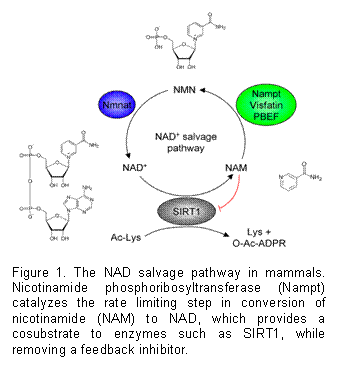Entrez 10135 | Ensembl ENSG00000105835 | |
 | ||
External IDs MGI: 1929865 HomoloGene: 4201 GeneCards: NAMPT | ||
Medical vocabulary what does nicotinamide phosphoribosyltransferase mean
Nicotinamide phosphoribosyltransferase (NAmPRTase or Nampt) also known as pre-B-cell colony-enhancing factor 1 (PBEF1) or visfatin is an enzyme that in humans is encoded by the PBEF1 gene. This protein has also been reported to be a cytokine (PBEF) that promotes B cell maturation and inhibits neutrophil apoptosis.
Contents
- Medical vocabulary what does nicotinamide phosphoribosyltransferase mean
- Expression Regulation
- Reaction
- Function
- Nomenclature
- History
- Hormone claim retracted
- As a drug target
- References
Expression & Regulation
NAMPT is downregulated by an increase of miR-34a in obesity via a 3'UTR functional binding site of NAMPT mRNA resulting in a reduction of NAD(+) and decreased SIRT1 activity.
Reaction
NAmPRTase catalyzes the following chemical reaction:
nicotinamide D-ribonucleotide + diphosphateThus, the two substrates of this enzyme are nicotinamide D-ribonucleotide and diphosphate, whereas its two products are nicotinamide and 5-phospho-alpha-D-ribose 1-diphosphate.
This enzyme belongs to the family of glycosyltransferases, to be specific, the pentosyltransferases. This enzyme participates in nicotinate and nicotinamide metabolism.
Function
NAmPRTase catalyzes the condensation of nicotinamide with 5-phosphoribosyl-1-pyrophosphate to yield nicotinamide mononucleotide, one step in the biosynthesis of nicotinamide adenine dinucleotide. The protein is an adipokine that is localized to the bloodstream and has various functions, including the promotion of vascular smooth muscle cell maturation and inhibition of neutrophil apoptosis. It also activates insulin receptor and has insulin-mimetic effects, lowering blood glucose and improving insulin sensitivity. The protein is highly expressed in visceral fat and serum levels of the protein correlate with obesity. This gene has a pseudogene on chromosome 10.
Nomenclature
The systematic name of this enzyme class is nicotinamide-nucleotide:diphosphate phospho-alpha-D-ribosyltransferase. Other names in common use include:
History
Nampt/PBEF/visfatin was originally cloned as a putative cytokine shown to enhance the maturation of B cell precursors in the presence of Interleukin-7 (IL-7) and stem cell factor, it was therefore named “pre-B cell colony-enhancing factor” (PBEF). When the gene encoding the bacterial nicotinamide phosphoribosyltransferase (nadV) was first isolated in Haemophilus ducreyi, it was found to exhibit significant homology to the mammalian PBEF gene. Rongvaux et al. demonstrated genetically that the mouse PBEF gene conferred Nampt enzymatic activity and NAD-independent growth to bacteria lacking nadV. Revollo et al. determined biochemically that the mouse PBEF gene product encodes a Nampt enzyme, capable of modulating intracellular NAD levels. Others have since confirmed these findings. More recently, several groups have reported the crystal structure of Nampt/PBEF/visfatin and they all show that this protein is a dimeric type II phosphoribosyltransferase enzyme involved in NAD biosynthesis.
Hormone claim retracted
Although the original cytokine function of PBEF has not been confirmed to date, others have since reported or suggested a cytokine-like function for this protein. In particular, Nampt/PBEF was recently re-identified as a “new visceral fat-derived hormone” named visfatin. It is reported that visfatin is enriched in the visceral fat of both humans and mice and that its plasma levels increase during the development of obesity. Noteworthy is that visfatin is reported to exert insulin-mimetic effects in cultured cells and to lower plasma glucose levels in mice by binding to and activating the insulin receptor. However, the physiological relevance of visfatin is still in question because its plasma concentration is 40 to 100-fold lower than that of insulin despite having similar receptor-binding affinity. In addition, the ability of visfatin to bind and activate the insulin-receptor has yet to be confirmed by other groups.
On 26 October 2007, A. Fukuhara (first author), I.Shimomura (senior author) and the other co-authors of the paper, who first described Visfatin as a visceral-fat derived hormone that acts by binding and activating the insulin receptor, retracted the entire paper at the suggestion of the editor of the journal 'Science' and recommendation of the Faculty Council of Osaka University Medical School after a report of the Committee for Research Integrity.
As a drug target
APO866 is an experimental drug that inhibits this enzyme. It is being tested for treatment of advanced melanoma, cutaneous T-cell lymphoma (CTL), and refractory or relapsed B-chronic lymphocytic leukemia.
Anti-aging biomedical company Calico has licensed the experimental P7C3 analogs involved in enhancing NAMPT activity. P7C3 compounds have been shown in a number of publications to be beneficial in animal models for age-related neurodegeneration.
